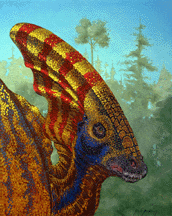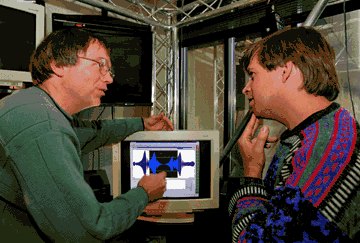
It’s a roar from the past. The distant past. The Late Cretaceous to be exact. Scientists at Sandia and the New Mexico Museum of Natural History and Science have collaborated to recreate the sound a dinosaur made 75 million years ago.
The low-frequency sound was produced by computer scientists and paleontologists using computed tomography (CT) scans and powerful computers.
The sound was trumpeted at a joint news conference in Albuquerque Dec. 5, to the interest and delight of news media worldwide (see “Media blitz blares dino sound worldwide”).
The study of dinosaur vocalization began after the discovery in August 1995 in northwestern New Mexico of a rare Parasaurolophus skull fossil measuring about 4.5 feet long. The dinosaur had a bony tubular crest that extended back from the top of its head. Many scientists have believed the crest, containing a labyrinth of air cavities and shaped something like a trombone, might have been used to produce distinctive sounds. As expected, based on the structure of the crest, the dinosaur apparently emitted a resonating low-frequency rumbling sound that can change in pitch. Each Parasaurolophus probably had a voice that was distinctive enough to distinguish it not only from other dinosaurs, but also from other Parasaurolophuses.
Sound and socialization

Since it’s uncertain whether the Parasaurolophus had vocal cords, a variation of sounds with and without vocal cords was simulated.
“The sound may have been somewhat birdlike, and it’s probably not unreasonable to think they did songs of some sort to call one another,” Carl says. “Fossil records of the large bones in the dinosaur’s ears compared to corresponding bones in human ears suggest they were able to hear lower frequencies than humans.”
Williamson speculates that the dinosaur’s ability to make distinctive sounds probably enhanced its tendency to socialize with other Parasaurolophuses.
The computer-modeling techniques used to create the dinosaur sound are the same ones Sandia uses to create complex, three-dimensional models for conducting computer simulations of problems that cannot be subjected to real-world tests. Sandia has used X-ray tomography similar to the CT scans taken on the dinosaur to develop advanced-imaging techniques for manufacturing design and testing.
The dinosaur imaging allowed Sandia scientists to expand their own computing skills in developing and applying those complicated codes. The basic science work is funded by DOE’s Office of Computer Technology and Research under the auspices of the Mathematics, Information, and Computer Science (MICS) program.
Parasaurolophus, one of the dinosaurs that appeared in the films Jurassic Park and The Lost World, lived during the Late Cretaceous Period, about 75 million years ago. The crest of the Parasaurolophus was unearthed near Farmington on public land administered by the Bureau of Land Management. The well-preserved skull includes a nearly complete crest, lacking only the segment below the eyes, making it the second-most complete skull of a Parasaurolophus known.
From CT scans to sound
“Not only are there more tubes than the simple, trombone-like loops described in previous studies, but there are new chambers within the crest,” Williamson says.
The use of digital paleontology, Williamson says, permitted a thorough analysis of the inside of the crest without having to physically cut through it, and thereby damaging it. The cross sections were loaded in numerical form into a computer in order to reconstruct an undistorted crest. Carl and Williamson studied the images and instructed the computer how to read the density variations in order to sort out what was bone and what was the sandstone and clay that fills and encases the fossil.
Once the size and shape of the air passages were determined with the aid of powerful computers and unique software, it was possible to determine the natural frequency of the sound waves the dinosaur pumped out, much the same as the size and shape of a musical instrument governs its pitch and tone. High-performance computers were used to do the initial image processing, analysis, and actual sound creation, including a Compaq Computer professional workstation, an Intergraph Corporation TDZ workstation, and a Silicon Graphics infinite reality workstation.
“A very complex shape such as the dinosaur crest takes lots and lots of numbers to describe the shape in the computer,” Carl says. “It’s only recently computers have become powerful enough to allow that to happen.”
Once the 3-D model was completed, the computer was able to simulate blowing air through the crest to amplify the tones it was capable of making.
More downloadable sounds and videos are available at http://www.sandia.gov/media/dinosaur.htm